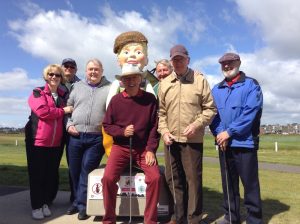
All is quiet on a damp and dreich January morning on Links Parade, Carnoustie. The scene at the same spot in July for The Open Championship will be a little different. As, it is hoped, will be the weather…
Some of the great names in world golf lifted the Claret Jug at Carnoustie – Hogan, Player, Watson, Harrington and our own Lawrie. Inside the newly-refurnished Carnoustie Golf Club clubhouse, memories are the order of the day.
The Club Captain, Bill Thompson, is giving a talk on the treasure trove of memorabilia that is dotted across the rooms, linking the Angus town with past and present. The audience lap it up, enjoying the walks down memory lane – which is precisely why they are gathered for their monthly meeting.
The Carnoustie Golf Memories Group is one of a number that is springing up at Golf Centres across the country. They are part of the overall Golf Memories Project, as part of the Sports Heritage Scotland network to help those living with memory loss conditions, notably dementia.
Scotland currently leads the world in reminiscence therapy. Football, cricket, curling, rugby and shinty are among the sports also involved, a collaborative effort of reminiscence groups to stir memories, fulfil lives and also encourage them back into the sports they love.
Lorraine Young is a key driving force for the golf group in Carnoustie. A former Chief Social Work Officer for Angus and a Rotarian, she chose to commit her free time to creating and supporting the development of Golf Memories. Launched in the Golf Hotel in June 2015, the group has been meeting monthly ever since. The group is ably supported by a committed and dedicated team of local volunteers, such as David Taylor and Trevor Williamson.
Stories of their own personal achievements in golf, and the making and caring for golf equipment, add a richness of golf knowledge and information for sharing.
“As well as reminisce, they are also getting back into the physical act of playing golf,” explains Lorraine. “For many, when they have a diagnosis of dementia, they believe they can’t play golf anymore or have a place in clubs like Carnoustie Golf Club. What we’re trying to do is show that physical activity and social interaction are very important by supporting members to reconnect with what for many has been a life long passion.
“What better setting for golf than here at Carnoustie which is steeped in history. We’re trying to get people back into doing that as much as is physically possible.”
Around 15 individuals are involved in the group, aged from the late 60s into the 90’s, with numbers hopeful of expansion when the group move into the new Carnoustie Links Golf Centre, which is impressively taking shape in time for welcoming the world’s oldest Major Championship this summer.
“Depending on the weather, we have ‘The Nestie’, a short six-hole par3 course which we can play on. Alternatively, we show off our putting skills on the Public Putting Green, all this is in competition for our own ‘Claret Jug’ man of the match award,” adds Lorraine. “Colin Sinclair, the PGA Head Professional, and his staff, are extremely helpful and supportive with the group and without the level of endorsement, afforded to us by the Links Committee and staff, most of what we aim to do, would not be possible.
“We also try to vary our programme by going off on different day trips, to the likes of The Himalayas and Museum at St Andrews and Kingarrock for the hickory golf experience. We also have our own home of golf in the Carnoustie Golf Club, a visit which stimulates a lot of conversations and evokes many memories.”
Stories abound, as Lorraine continues, her face lighting up as she retells. “We have a lady who attended our group , who used walking aids and needed a lot of support from a mobility point of view. But when we got her into the simulation bay and placed a golf club in her hands, she stood up straight as a die and must have gone back about 40 years. She hit the sweetest and purest of shots, it was a delight to watch. That is what it is all about, as well as the stories and the camaraderie. They are a really colourful group, with so much to share.”
“We have obtained a lot of photos from Donald and they, in themselves, stimulate many memories and conversations. But I believe that getting out onto the course and the physical activity itself, is perhaps more powerful and valuable for people to help keep better health. After a diagnosis, it can very much feel like a loss of life, however this programme is helping people change their attitudes.”
Article originally posted on scottishgolf.org



